[English] 日本語
 Yorodumi
Yorodumi- PDB-5mkf: cryoEM Structure of Polycystin-2 in complex with calcium and lipids -
+ Open data
Open data
- Basic information
Basic information
| Entry | Database: PDB / ID: 5mkf | |||||||||
|---|---|---|---|---|---|---|---|---|---|---|
| Title | cryoEM Structure of Polycystin-2 in complex with calcium and lipids | |||||||||
 Components Components | Polycystin-2 | |||||||||
 Keywords Keywords | TRANSPORT PROTEIN / Ca2+ signaling / cryoEM / membrane protein structure / Polycystin-2 / TRP channel | |||||||||
| Function / homology |  Function and homology information Function and homology informationdetection of nodal flow / metanephric smooth muscle tissue development / metanephric cortex development / metanephric cortical collecting duct development / metanephric distal tubule development / polycystin complex / mesonephric tubule development / mesonephric duct development / metanephric part of ureteric bud development / determination of liver left/right asymmetry ...detection of nodal flow / metanephric smooth muscle tissue development / metanephric cortex development / metanephric cortical collecting duct development / metanephric distal tubule development / polycystin complex / mesonephric tubule development / mesonephric duct development / metanephric part of ureteric bud development / determination of liver left/right asymmetry / renal tubule morphogenesis / metanephric ascending thin limb development / HLH domain binding / metanephric mesenchyme development / metanephric S-shaped body morphogenesis / renal artery morphogenesis / basal cortex / positive regulation of inositol 1,4,5-trisphosphate-sensitive calcium-release channel activity / migrasome / cilium organization / VxPx cargo-targeting to cilium / detection of mechanical stimulus / calcium-induced calcium release activity / voltage-gated monoatomic ion channel activity / muscle alpha-actinin binding / cation channel complex / regulation of calcium ion import / placenta blood vessel development / cellular response to hydrostatic pressure / outward rectifier potassium channel activity / cellular response to fluid shear stress / non-motile cilium / cellular response to osmotic stress / actinin binding / voltage-gated monoatomic cation channel activity / motile cilium / transcription regulator inhibitor activity / aorta development / determination of left/right symmetry / inorganic cation transmembrane transport / voltage-gated sodium channel activity / neural tube development / ciliary membrane / protein heterotetramerization / branching involved in ureteric bud morphogenesis / negative regulation of G1/S transition of mitotic cell cycle / spinal cord development / heart looping / negative regulation of ryanodine-sensitive calcium-release channel activity / cytoplasmic side of endoplasmic reticulum membrane / centrosome duplication / cell surface receptor signaling pathway via JAK-STAT / voltage-gated potassium channel activity / potassium channel activity / embryonic placenta development / voltage-gated calcium channel activity / sodium ion transmembrane transport / monoatomic cation channel activity / cellular response to cAMP / release of sequestered calcium ion into cytosol / cytoskeletal protein binding / potassium ion transmembrane transport / cellular response to calcium ion / liver development / basal plasma membrane / ciliary basal body / establishment of localization in cell / phosphoprotein binding / lumenal side of endoplasmic reticulum membrane / protein tetramerization / calcium ion transmembrane transport / cytoplasmic vesicle membrane / cilium / mitotic spindle / Wnt signaling pathway / intracellular calcium ion homeostasis / cellular response to reactive oxygen species / calcium ion transport / positive regulation of nitric oxide biosynthetic process / cell-cell junction / lamellipodium / heart development / regulation of cell population proliferation / ATPase binding / positive regulation of cytosolic calcium ion concentration / basolateral plasma membrane / protein homotetramerization / transmembrane transporter binding / cell surface receptor signaling pathway / regulation of cell cycle / negative regulation of cell population proliferation / signaling receptor binding / calcium ion binding / endoplasmic reticulum membrane / positive regulation of gene expression / Golgi apparatus / endoplasmic reticulum / protein homodimerization activity / positive regulation of transcription by RNA polymerase II / extracellular exosome Similarity search - Function | |||||||||
| Biological species |  Homo sapiens (human) Homo sapiens (human) | |||||||||
| Method | ELECTRON MICROSCOPY / single particle reconstruction / cryo EM / Resolution: 4.2 Å | |||||||||
 Authors Authors | Wilkes, M. / Madej, M.G. / Ziegler, C. | |||||||||
 Citation Citation |  Journal: Nat Struct Mol Biol / Year: 2017 Journal: Nat Struct Mol Biol / Year: 2017Title: Molecular insights into lipid-assisted Ca regulation of the TRP channel Polycystin-2. Authors: Martin Wilkes / M Gregor Madej / Lydia Kreuter / Daniel Rhinow / Veronika Heinz / Silvia De Sanctis / Sabine Ruppel / Rebecca M Richter / Friederike Joos / Marina Grieben / Ashley C W Pike / ...Authors: Martin Wilkes / M Gregor Madej / Lydia Kreuter / Daniel Rhinow / Veronika Heinz / Silvia De Sanctis / Sabine Ruppel / Rebecca M Richter / Friederike Joos / Marina Grieben / Ashley C W Pike / Juha T Huiskonen / Elisabeth P Carpenter / Werner Kühlbrandt / Ralph Witzgall / Christine Ziegler /   Abstract: Polycystin-2 (PC2), a calcium-activated cation TRP channel, is involved in diverse Ca signaling pathways. Malfunctioning Ca regulation in PC2 causes autosomal-dominant polycystic kidney disease. Here ...Polycystin-2 (PC2), a calcium-activated cation TRP channel, is involved in diverse Ca signaling pathways. Malfunctioning Ca regulation in PC2 causes autosomal-dominant polycystic kidney disease. Here we report two cryo-EM structures of distinct channel states of full-length human PC2 in complex with lipids and cations. The structures reveal conformational differences in the selectivity filter and in the large exoplasmic domain (TOP domain), which displays differing N-glycosylation. The more open structure has one cation bound below the selectivity filter (single-ion mode, PC2), whereas multiple cations are bound along the translocation pathway in the second structure (multi-ion mode, PC2). Ca binding at the entrance of the selectivity filter suggests Ca blockage in PC2, and we observed density for the Ca-sensing C-terminal EF hand in the unblocked PC2 state. The states show altered interactions of lipids with the pore loop and TOP domain, thus reflecting the functional diversity of PC2 at different locations, owing to different membrane compositions. | |||||||||
| History |
|
- Structure visualization
Structure visualization
| Movie |
 Movie viewer Movie viewer |
|---|---|
| Structure viewer | Molecule:  Molmil Molmil Jmol/JSmol Jmol/JSmol |
- Downloads & links
Downloads & links
- Download
Download
| PDBx/mmCIF format |  5mkf.cif.gz 5mkf.cif.gz | 413.8 KB | Display |  PDBx/mmCIF format PDBx/mmCIF format |
|---|---|---|---|---|
| PDB format |  pdb5mkf.ent.gz pdb5mkf.ent.gz | 321.3 KB | Display |  PDB format PDB format |
| PDBx/mmJSON format |  5mkf.json.gz 5mkf.json.gz | Tree view |  PDBx/mmJSON format PDBx/mmJSON format | |
| Others |  Other downloads Other downloads |
-Validation report
| Summary document |  5mkf_validation.pdf.gz 5mkf_validation.pdf.gz | 1.6 MB | Display |  wwPDB validaton report wwPDB validaton report |
|---|---|---|---|---|
| Full document |  5mkf_full_validation.pdf.gz 5mkf_full_validation.pdf.gz | 1.7 MB | Display | |
| Data in XML |  5mkf_validation.xml.gz 5mkf_validation.xml.gz | 79.3 KB | Display | |
| Data in CIF |  5mkf_validation.cif.gz 5mkf_validation.cif.gz | 109.2 KB | Display | |
| Arichive directory |  https://data.pdbj.org/pub/pdb/validation_reports/mk/5mkf https://data.pdbj.org/pub/pdb/validation_reports/mk/5mkf ftp://data.pdbj.org/pub/pdb/validation_reports/mk/5mkf ftp://data.pdbj.org/pub/pdb/validation_reports/mk/5mkf | HTTPS FTP |
-Related structure data
| Related structure data |  3524MC  3523C  5mkeC M: map data used to model this data C: citing same article ( |
|---|---|
| Similar structure data |
- Links
Links
- Assembly
Assembly
| Deposited unit | 
|
|---|---|
| 1 |
|
- Components
Components
-Protein , 1 types, 4 molecules ABCD
| #1: Protein | Mass: 109820.086 Da / Num. of mol.: 4 Source method: isolated from a genetically manipulated source Source: (gene. exp.)  Homo sapiens (human) / Gene: PKD2, TRPP2 / Cell line (production host): HEK293 / Production host: Homo sapiens (human) / Gene: PKD2, TRPP2 / Cell line (production host): HEK293 / Production host:  Homo sapiens (human) / References: UniProt: Q13563 Homo sapiens (human) / References: UniProt: Q13563 |
|---|
-Sugars , 2 types, 16 molecules 
| #2: Polysaccharide | 2-acetamido-2-deoxy-beta-D-glucopyranose-(1-4)-2-acetamido-2-deoxy-beta-D-glucopyranose Source method: isolated from a genetically manipulated source #3: Sugar | ChemComp-NAG / |
|---|
-Non-polymers , 4 types, 29 molecules 






| #4: Chemical | ChemComp-PX6 / #5: Chemical | ChemComp-PLM / #6: Chemical | ChemComp-CHS / #7: Chemical | ChemComp-CA / |
|---|
-Experimental details
-Experiment
| Experiment | Method: ELECTRON MICROSCOPY |
|---|---|
| EM experiment | Aggregation state: PARTICLE / 3D reconstruction method: single particle reconstruction |
- Sample preparation
Sample preparation
| Component | Name: Polycystin-2 / Type: COMPLEX / Entity ID: #1 / Source: RECOMBINANT |
|---|---|
| Source (natural) | Organism:  Homo sapiens (human) Homo sapiens (human) |
| Source (recombinant) | Organism:  Homo sapiens (human) Homo sapiens (human) |
| Buffer solution | pH: 7.5 |
| Specimen | Embedding applied: NO / Shadowing applied: NO / Staining applied: NO / Vitrification applied: YES |
| Vitrification | Cryogen name: ETHANE |
- Electron microscopy imaging
Electron microscopy imaging
| Microscopy | Model: JEOL 3200FSC |
|---|---|
| Electron gun | Electron source:  FIELD EMISSION GUN / Accelerating voltage: 300 kV / Illumination mode: FLOOD BEAM FIELD EMISSION GUN / Accelerating voltage: 300 kV / Illumination mode: FLOOD BEAM |
| Electron lens | Mode: BRIGHT FIELD / Cs: 4.1 mm |
| Image recording | Electron dose: 1.8 e/Å2 / Film or detector model: GATAN K2 SUMMIT (4k x 4k) |
- Processing
Processing
| Software | Name: PHENIX / Version: 1.10.1_2155: / Classification: refinement | ||||||||||||||||||||||||
|---|---|---|---|---|---|---|---|---|---|---|---|---|---|---|---|---|---|---|---|---|---|---|---|---|---|
| EM software | Name: PHENIX / Category: model fitting | ||||||||||||||||||||||||
| CTF correction | Type: PHASE FLIPPING AND AMPLITUDE CORRECTION | ||||||||||||||||||||||||
| Symmetry | Point symmetry: C4 (4 fold cyclic) | ||||||||||||||||||||||||
| 3D reconstruction | Resolution: 4.2 Å / Resolution method: FSC 0.143 CUT-OFF / Num. of particles: 35318 / Symmetry type: POINT | ||||||||||||||||||||||||
| Atomic model building | Space: REAL Details: we used for comparative structure modeling TRPA1 (pdb entry code 3J9P) as template for S1 and S3-S5, TRPV1 (pdb entry code 3J5Q) for S5-S6, and the TRPV2 (pdb entry code 5AN8) fitted best ...Details: we used for comparative structure modeling TRPA1 (pdb entry code 3J9P) as template for S1 and S3-S5, TRPV1 (pdb entry code 3J5Q) for S5-S6, and the TRPV2 (pdb entry code 5AN8) fitted best for S2-S3 to obtain an initial model. The soluble domain was build based on pdbID: 5K47. But we had no search model for molecular replacement. Although we had a good idea what the architecture would be like, we build the model de novo with COOT. | ||||||||||||||||||||||||
| Refine LS restraints |
|
 Movie
Movie Controller
Controller



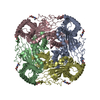
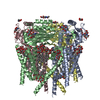

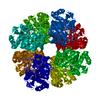
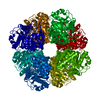

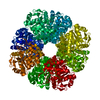
 PDBj
PDBj










